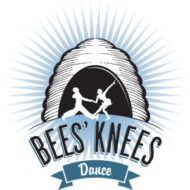Swing dances are a family of African American social dances originating in the 1920’s, which are closely related to other African American street dances including as Hip Hop, Soul, and Disco. With 95+ years of history, these dances have persisted and remain popular.
Swing dancing can be traced back to earlier social dances including the Charleston, the Cakewalk, and Texas Tommy, and has deeper roots in African dance traditions. Bees’ Knees Dance specializes in teaching a swing dance called Lindy Hop. Social dancing was revolutionized when partners began to “break-away” or “swing-out” as its more commonly called today (before this point social dances were danced in a closed position) – this is how Lindy Hop was born. Lindy Hop began in the ballrooms of New York City – most notably those located in Harlem; the Savoy ballroom being the most famous and significant of them all. It is a lively dance created to match the swing rhythms derived from the big bands of the time and is most notable for its use of triple steps and “Airsteps” – the acrobatic dance steps introduced by Frankie Manning in 1935.
Lindy Hop also made its way to the west coast where it was featured in Hollywood movies; many of the dancers from the west coast began to dance in their own unique way creating other styles of Lindy Hop and even entirely new dances. One of these dances was born of necessity – Balboa, named after the dance halls of Balboa Peninsula in California where the dance floors were so crowded that “break-aways” were banned.
Lindy hop remained popular right up until the end of WWII; many of the soldiers returned from the war and settled down. The youths’ taste in music began to shift away from swing and began to centre on rock ‘n’ roll. Although this marked the end of the “Swing Era,” Lindy Hop persisted outside of the mainstream. The steps of earlier swing dances were also adapted to form a new dance, rock ‘n’ roll (a.k.a. boogie woogie).
There were several swing dances that came later adapting the steps of earlier dance forms to fit the music of their time and many off-shoots have been created since. Other dance styles include Collegiate Shag, West Coast Swing, East Coast Swing, Carolina Shag, and many more.
Black populations in America have faced ongoing racial discrimination and have often been excluded from opportunities to showcase Lindy Hop. We hope that this relationship can be repaired as we work together to create a more inclusive community which is committed to supporting the work of black dancers.
For further reading, please check out our friends at iLindy.com and Dance Sage.
